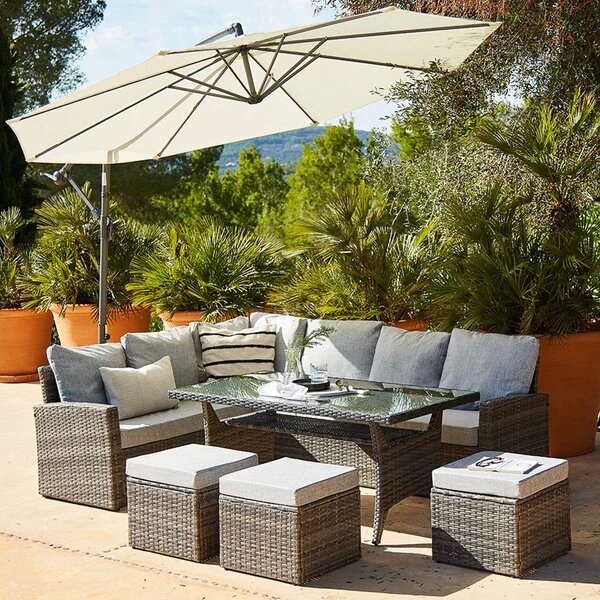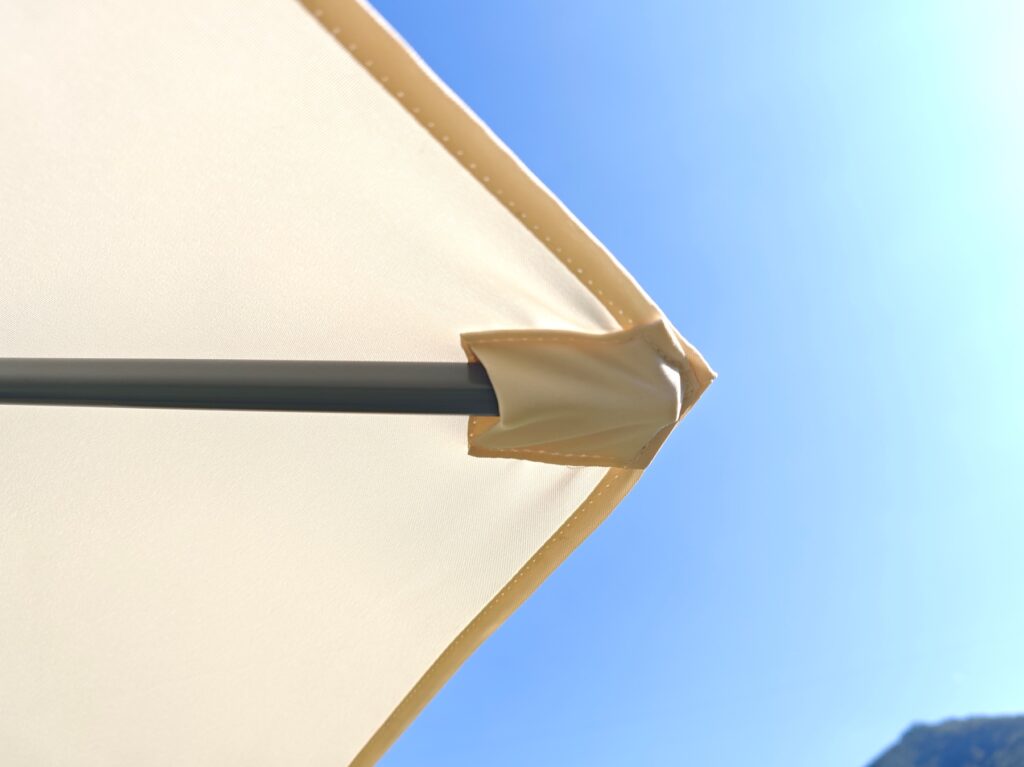Did you know that garden parasols are among the most sought-after garden accessories in the UK with over 20,000 people searching for them every single month?
Whether you are hosting a summer barbecue or simply relaxing with a book, the right parasol can make all the difference – not just for comfort but for your health too. After all, a good parasol can reduce the temperature beneath it by up to 10 degrees!
But choosing the perfect parasol isn’t as straightforward as it might seem. From size considerations (your parasol should extend at least 50cm over each side of your table) to deciding between a classic centre-pole parasol or a versatile cantilever design, there is quite a bit to think about.
When it comes to sizing, many people underestimate their needs. For instance, a 4-seater table generally requires a 2.4 metre parasol, while a 6 seater table needs something in the 2.7 metre range. Get it wrong, and you will be shifting your chairs to chase the shade all afternoon!
In this comprehensive guide, we will help you navigate everything from parasol types and sizes to materials and essential accessories like the often overlooked parasol base. Let’s find your perfect outdoor shade solution together!
What is a garden parasol and why use one?
A garden parasol stands as an essential outdoor accessory, providing much more than mere decoration for your garden or patio. Essentially, a garden parasol is a specialised umbrella designed primarily to protect you from the sun’s rays, creating a comfortable shaded area in your outdoor space.
Parasol vs umbrella: key differences
Though often used interchangeably, parasols and umbrellas serve distinctly different purposes. A parasol, derived from the Latin words “para” (to shield) and “sol” (sun), is specifically designed for sun protection. In contrast, an umbrella’s primary function is to shield you from rain.
The design differences are notable too. Parasols typically feature lighter, more decorative materials with less rigid frameworks, making them ideal for sun protection rather than withstanding heavy rainfall. Moreover, garden parasols often come with specialised features like crank mechanisms for easy opening and closing, plus tilt functions that allow you to adjust the shade as the sun moves across the sky.
For those seeking versatile options, a 360-degree rotating parasol with base offers maximum flexibility, letting you follow the sun throughout the day without moving the entire unit.
Benefits of outdoor shade in summer
The advantages of having proper shade in your garden extend far beyond comfort. First and foremost, garden parasols provide crucial protection from harmful UV rays, significantly reducing your risk of sunburn and potential long-term skin damage.
Additionally, a well-placed parasol can create an area that’s noticeably cooler. The shade beneath a quality parasol can reduce the temperature by approximately 15 degrees compared to direct sunlight, making outdoor activities much more enjoyable during hot summer days.
For families with children or pets, a 3m cantilever parasol creates a safe haven during the hottest part of the day, ensuring everyone can enjoy the garden without overexposure to direct sunshine.
Aesthetic and functional value
Beyond their practical benefits, garden parasols serve as stylish centrepieces that enhance the visual appeal of any outdoor setting. They come in various designs, from classic 2.7m steel parasols to innovative double-sided parasols for larger areas.
From a functional perspective, parasols add considerable versatility to your outdoor space. They transform areas that might otherwise be unusable during peak sunshine hours into comfortable spots for dining al fresco, reading, or simply relaxing. Furthermore, they protect your garden furniture and fabrics from sun damage and fading.
For those seeking to create a cosy atmosphere during autumn and winter evenings, parasols can be creatively repurposed. Simply suspend lanterns from the spokes or twist fairy lights around them to instantly add romantic mood lighting to your garden setting.
It’s worth noting that most parasols are sold without a base, so investing in a heavy-duty cantilever parasol base is essential to ensure stability, particularly in windy conditions. Browse our range of garden accessories to find the perfect companion pieces for your new parasol.
Different types of parasols for every space
Choosing from the variety of garden parasols available means finding the perfect match for your unique outdoor space. The right design can transform how you use your garden or patio throughout the changing seasons.
Centre-pole vs cantilever parasols
The most fundamental choice when selecting a garden parasol is between traditional centre-pole and modern cantilever designs.
Centre-pole parasols feature a straight pole running through the middle of the canopy. They’re the classic choice for garden tables with a central hole, offering excellent stability and balance. These parasols are typically more affordable and come in various sizes and materials, with polyester being the common choice for the canopy and spokes usually made from steel, aluminium, or wood.
Cantilever parasols (sometimes called overhanging, side arm, or side post parasols) are designed with a side pole that keeps the space underneath completely clear. This 3m cantilever parasol design is ideal if:
-
Your table doesn’t have a central hole
-
You want to shade a jacuzzi or seating area
-
You prefer a more luxurious, contemporary look
However, cantilever models require a heavier base for stability and typically cost more than centre-pole versions. For optimal stability, a heavy-duty cantilever parasol base is essential, especially in windy conditions.
Tilting garden parasol for flexible shade
Tilting parasols offer exceptional versatility by allowing you to adjust the canopy angle as the sun moves across the sky. A quality tilting garden parasol typically operates via an easy-to-use crank handle that both unfolds the parasol and tilts the upper part of the central mast.
Many models feature UV protection, with fabrics containing ultraviolet inhibitors (UVIs) that keep colours vibrant while protecting you from harmful rays. Additionally, higher-end models often include:
-
Water-repellent polyester canopies
-
Air vents for improved stability
-
Tilting mechanisms that work on two axes (vertical and lateral)
For maximum flexibility, consider a 360-degree rotating parasol with base that lets you adjust shade coverage throughout the day without moving the entire structure.
Wall-mounted and half parasols for small spaces
For compact gardens, balconies, or narrow terraces, specialised space-saving options are available.
Wall-mounted parasols attach directly to exterior walls via a bracket, eliminating the need for floor space entirely. They can rotate up to 360° to direct shade precisely where needed and fold flat against the wall when not in use. This makes them perfect for balconies, small patios, or alongside garden walls where floor space is at a premium.
Half parasols (or balcony parasols) feature a semi-circular canopy designed to sit flush against a wall or railing. These ingenious designs take up minimal space while still providing effective shade. Many models include tilting capabilities, allowing you to adjust the shade as the sun moves, despite their compact footprint.
For a stylish garden centrepiece, consider a 2.7m steel parasol for larger spaces or explore our range of garden accessories to complement your chosen parasol.
How to pick the right size parasol
Selecting the correct garden parasol size makes all the difference between adequate shade and constantly shifting chairs to escape the sun. According to research, thousands of UK residents purchase incorrectly sized parasols each year, leading to frustration and wasted money.
Understanding canopy dimensions
When discussing parasol sizes, we’re primarily referring to the width of the canopy, not the height of the pole. Parasol dimensions are typically measured in metres, with standard sizes ranging from 2m to 4m+ in diameter. For round parasols, the measurement represents the diameter, whereas for square parasols, it indicates the length of each side.
To accurately measure an existing parasol canopy, you can use two methods:
-
Extended measurement: Measure from the tip of one rib to the centre hub, then multiply by two.
-
Folded measurement: Remove the canopy, fold it in half, and measure across the widest point.
If you’re considering a 360-degree rotating parasol with base, understanding precise dimensions becomes even more crucial as these models need adequate clearance for rotation.
Parasol size guide by table seating
Matching your parasol to your table size ensures everyone stays comfortably shaded. Here’s a quick guide by seating capacity:
-
2-seater tables: 2m parasol ideal
-
4-seater tables: 2m to 2.3m parasol
-
6-seater tables: 2.7m to 3m parasol, like our 2.7m steel parasol
-
8-seater tables: 3m parasol, such as a 3m cantilever parasol
-
10-seater tables: 4m+ or consider a double-sided parasol for extensive coverage
For optimal shade, your parasol should extend beyond the table’s edges by approximately 50cm on all sides. This ensures everyone seated remains protected from UV rays.
Tips for measuring your space
Start by measuring your outdoor space. You need to know the width and length of the area where the parasol will go. Clear everything out first so you get accurate measurements. Cantilever parasols need extra space because they rotate.
If you’re covering a table, measure that too. Round tables that seat four to six people usually need a 2.4m to 3m parasol. You want at least 7 feet of clearance between the ground and the bottom of the canopy so no one bumps their head.
The base is important. A 3m parasol needs a base that weighs 20-30kg. Cantilever models need even heavier bases because they’re more likely to tip over when it’s windy. A flimsy base won’t cut it.
You can find bases and other equipment in our garden accessories section.
Materials and build quality to consider
The quality of materials used in garden parasols directly influences their longevity, performance, and price. Making informed choices about fabrics and frame materials ensures you’ll get the most value from your investment.
Canopy fabrics: polyester vs acrylic
Polyester remains the most common parasol fabric due to its affordability and decent performance. Standard polyester canopies offer UV protection of 30+ to 50+, alongside basic water resistance for light summer showers. Polyester fabrics primarily excel in being economical, lightweight, and quick-drying.
Acrylic fabrics, although costlier, represent the premium choice for serious shade seekers. These fabrics boast superior UV protection (UPF 80+), exceptional colour retention, and impressive resistance to fading, mould, and mildew. Notably, acrylic is solution-dyed, meaning colour permeates the entire fibre, maintaining vibrancy even after years of sun exposure.
Pole materials: aluminium, wood, steel
Aluminium poles offer excellent balance between weight and durability. They’re lightweight, rust-resistant, and ideal if you need to move your 360-degree rotating parasol with base frequently around your garden.
Wooden poles provide classic aesthetic appeal that complements traditional garden furniture. They require more maintenance but add natural charm to a 2.7m steel parasol or double-sided parasol.
Steel frames offer superior strength and stability, making them ideal for larger parasols like a 3m cantilever parasol. They’re heavier than both aluminium and wood, providing enhanced wind resistance.
Durability and weather resistance
Quality parasols include features that extend their lifespan, including fabric treatments for water-repellence and UV protection. High-end parasols incorporate tension springs that keep the canvas taut regardless of weather conditions.
Top canopy fabrics meet three essential requirements: 4+ years colour guarantee, waterproofing capabilities, and UV resistance. Most quality parasols include a vent at the canopy’s top to reduce wind pressure and improve air circulation.
For cantilever models, proper stabilisation is crucial—consider a heavy-duty cantilever parasol base to ensure your investment stands secure even in challenging conditions.
Essential accessories and buying tips
The success of your outdoor shade solution hinges largely on the accessories you choose. Investing in the right supplementary items consequently enhances both the functionality and lifespan of your garden parasol.
Choosing the right garden parasol base
Your parasol’s stability depends entirely on its base. For centre pole parasols under 3m, opt for a minimum weight of 50kg when freestanding. Larger 3.5m parasols require at least 30kg, whilst a heavy-duty cantilever parasol base needs 80-100kg for proper stability. In exposed or windy locations, consider going heavier—no one ever complains about their parasol being too stable!
Garden parasol with base vs without
A 360-degree rotating parasol with base offers convenience straight out of the box. Nonetheless, purchasing components separately allows customisation to your specific needs. Remember, even parasols through tables still need a base to maintain position. For cantilever models like the 3m cantilever parasol, separate cross-bases with concrete weights provide superior stability.
Protective covers and maintenance
A quality protective cover ranks as perhaps the most recommended accessory, potentially extending your parasol’s life for many years. Never close your parasol when wet as this leads to mould formation. Instead, leave it open until completely dry before storing.
Common mistakes to avoid when buying
The most critical error is underestimating base requirements. An unstable parasol becomes dangerous in wind, risking injury to people or property damage. Likewise, overlooking maintenance needs or choosing poor-quality materials will lead to premature replacement.
Conclusion
Choosing the right garden parasol ultimately comes down to understanding your specific outdoor space and needs. Throughout this guide, we’ve explored how parasols serve as more than just decorative elements – they provide essential protection from harmful UV rays while creating comfortable, cooler spaces for relaxation and entertainment.
Size certainly matters when selecting your perfect shade solution. Your parasol should extend at least 50cm beyond your table edges to ensure everyone stays protected. For larger gatherings, a double-sided parasol offers extensive coverage, while smaller spaces might benefit from wall-mounted or half parasols that maximize limited areas.
The type of parasol you select significantly impacts functionality. Centre-pole designs work wonderfully with tables featuring central holes, whereas a 3m cantilever parasol provides unobstructed shade perfect for seating areas or hot tubs. Families particularly appreciate how a 360-degree rotating parasol with base allows them to adjust shade coverage throughout the day without moving furniture.
Material quality should never be overlooked, as it directly determines your parasol’s longevity. Premium acrylic fabrics offer superior fade resistance and UV protection compared to standard polyester options. Similarly, sturdy frames like those found in a 2.7m steel parasol provide reliable performance season after season.
Most importantly, remember that even the finest parasol becomes dangerous without proper stabilisation. A heavy-duty cantilever parasol base represents an essential investment rather than an optional extra, especially for larger or freestanding models.
We hope this guide has illuminated the path to finding your perfect garden parasol. With the right shade solution in place, your garden transforms into an outdoor haven where you can safely enjoy even the sunniest British days. Additionally, protective covers and regular maintenance will extend your parasol’s life considerably, making it a worthwhile investment for years of outdoor enjoyment.
Before making your final decision, take time to measure your space accurately and consider how you’ll actually use your outdoor area. After all, the perfect parasol balances style, functionality, and durability while complementing your existing garden accessories to create a cohesive outdoor living space you’ll love.




